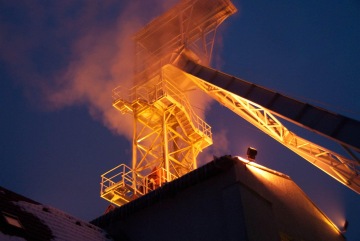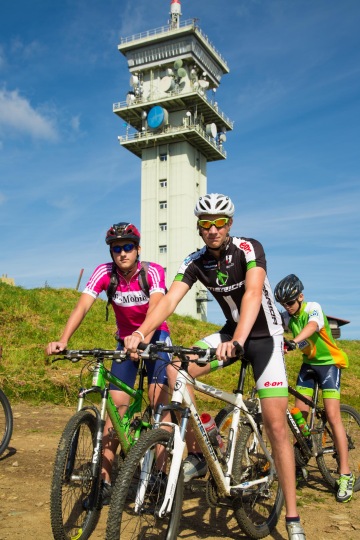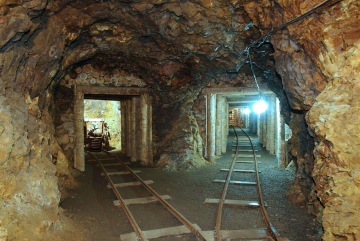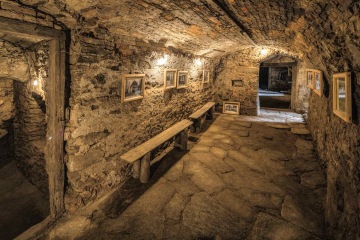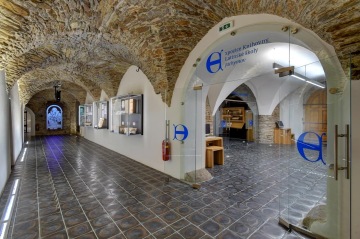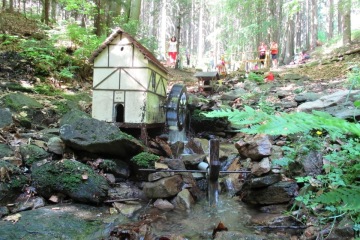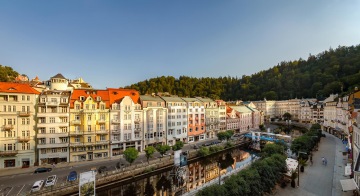Jáchymov spa
Tips for trips around Jáchymov
We have prepared for you an overview of places that you should not miss.
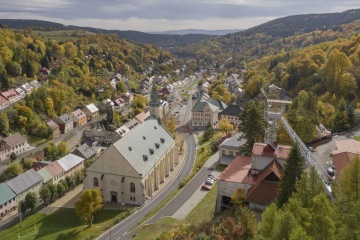
Discover the mining region of the Erzgebirge / Ore Mountains, which has been inscribed to the UNESCO World Heritage Site since 6 July 2019. It consists of 22 parts, which altogether show the evolution of the local mining activities during past 800 years.
Take a look video Krušné hory - Krajina horníků from the National Jewels series produced by Czech Television and you will see what awaits you here.Start at the top of the Klínovec mountain and follow the trails of four difficulties, all of which end at the chair-lift. This will comfortably take you back down, even with your bike. Children and beginners can definitely handle the easiest difficulty.
The network of the mountain bike trails, with a four-seat chair-lift, offers 30 km of trails of varying difficulty and 70 km of mountain bike trails marked by forest roads. It belongs definitely to the longest continuously descending trails in Europe..
JOURNEY UNDERGROUND
Shaft No.1 Jáchymov
Monuments for the extraction of silver and uranium ores include the Shaft No. 1 and the neighboring mine Svornost. The excavation took place here in the years 1952 – 1953.
The length is 230 m and one of the side corridors intersects the historical silver-bearing vein named Evangelist.
As established in 1520 after the Šlik family got the right to mint coins.
Today, the building houses a museum with an extensive exhibition - "Jáchymov in the Mirror of Time". Part of the exhibition is a cellar, where there is a lapidary of valuable stone elements from the demolished houses in Jáchymov
Visit a unique exhibition of old prints and manuscripts, placed in the cellars of the Jáchymov town hall. Most of the volumes date from the beginning of the 16th century.
Among others, the collection includes Old Testament from the 13th century and fragments of texts from the beginning of the 12th century.
OTHER TIPS FOR TRIPS:
To the Mill Valley
Spa hotel Radium Palace - Forest café - Valley of the Mills
The magical Valley of the Mills is literally a few steps from the spa center. A comfortable forest path leads you to it, starting behind the Radium Palace Hotel. You can tell that you have arrived at the right destination by the characteristic clacking that wooden mills sound this beautiful corner. Every spring, their ceremonial Opening takes place here. Scouts will clean the valley and stream, old mills will be repaired and new ones will be built. They are enjoyed not only by children, but also by skilful fathers and grandfathers, who are eagerly waiting to see how their mill will turn out in the overall rating...
AND WHY THE VALLEY OF THE MILLS?
Even 120 years ago, the area of today's spa park was furrowed by ditches of raceways bringing water to both the uranium dye factory and the mill wheels.
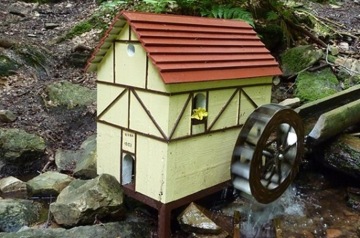
TThose mills were not just any - they were paper mills, i.e. paper mills. An entry in the chronicle from 1598 states that Adam Abt bought a smoothing plant above the village of Žďár and set up a paper mill there. Paper mills were established near the mining towns because the mines guaranteed a raw material base in the form of quickly worn out work clothes.
Bohuslav Balbín (1621 - 1688) wrote about the paper mill in his unfinished Homeland of Bohemia. According to him, the paper here "occupies the first place with goodness..." He heard the stationers say that all the Jáchymov paper was exported to Holland, and there it was made into a very smooth and very thin paper, which we admired in books published especially in Leyden. The Jáchymov paper is quite thick that the Dutch make two sheets from one of its sheets with great profit." You would still find witnesses who are not foreign to the name "Panský mlýn" or "Schöffl ́s mill". In the 30s, you could count more than 200 inhabitants with the surname Müller in Jáchymov.
(Mgr. Oldřich Ježek - chronicler of the town of Jáchymov)
1,5 Km
walk
intensity 1
low
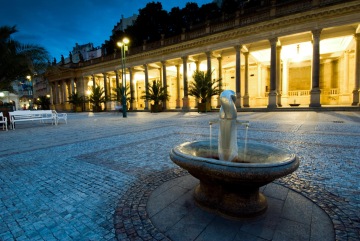
Carlsbad
Jáchymov - Ostrov - Carlsbad
Jáchymov to Karlovy Vary leads modified road I. class. You can park in paid car parks in the city centre. Cyclists can turn in the direction of Bor in Ostrov. After Bor, do not forget to turn left just before the start of Sadov and follow the marked cycle path to Karlovy Vary.The most famous Czech spa - Karlovy Vary - has in addition to healing springs and landscape beauty and captivating genius loci. Its sources and secrets have been trying to reveal for centuries by numerous admirers of the hot spring town. The Hot Spring Spring, which has literally become a meeting place for people from all over the world, was celebrated by painters, poets, musicians, sculptors, philanthropists and photographers. The famous architect Le Corbusier said: "Karlovy Vary has the greatest unity and architectural charm. It's a gathering of cakes. They have the same style and the same elegance." The alpha and omega of the city are mineral springs. Twelve main springs are collected and used for spa purposes, the most abundant and famous of which is called the Hot Spring.
The temperature of the springs ranges from 41 to 73 °C and has a positive effect mainly on diseases of the digestive system. You can penetrate directly into the thermal underground. A guide to the underground of the Karlovy Vary Hot Spring will introduce you to the history of the Karlovy Vary colonnades and the secrets of the production of the famous stone roses. Beautiful is a walk along the local colonnades, on Little Versailles and along the Old or New Meadow through the Grandhotel Pupp, Richmond to the Postal Court.
WHAT ELSE IS WORTH VISITING?
The thirteenth spring has been called the unique herbal liqueur Becherovka for almost 200 years. In Karlovy Vary you will find its museum, where you can learn about the history and present of the company and look into the historical cellars where Becherovka matures. At the end of the tour, you can properly enjoy this Karlovy Vary gem.
What would a trip to Karlovy Vary be if you did not visit the famous Moser glassworks? It was founded in 1857 by a talented merchant and talented glass engraver Ludwig Moser. As in the past, the Karlovy Vary glassworks is currently a renowned supplier of glass to royal courts and presidential palaces. Important personalities of culture and politics order their unique sets here.
View of Charles IV. - at the Grandhotel Pupp, get on the funicular and get off at the first station "Jelení skok". From here, a yellow hiking trail will lead you. The path is less than a kilometer long and you will meet the Ecce homo chapel from 1900 and Chopin's cottage. A longer route to the viewpoint is offered by the beginning of the route at Little Versailles. The oldest lookout tower (1877) in Karlovy Vary, built in pseudo-Gothic style, is a copy of the lookout tower from Schleswig, Germany. It has two battlement-lined galleries and is reached by just 79 steps. When visibility is good, the view of Krásenský vrch with a lookout tower is partially open.
Goethe's Lookout - you can take public transport No. 8 - stop Hůrky and walk along a short asphalt road around the observatory. For hungry tourists, we recommend starting the route in the city district of Drahovice and climbing to the top of the Three Crosses - from here you will have one of the most beautiful views of Karlovy Vary. A roughly 6 km long path leads around Otto's Hill to Goethe's Viewpoint. One of the oldest lookouts in Karlovy Vary (1889) measures 42 meters. After climbing 165 steps, you will see Karlovy Vary again from a different angle over the tops of mature trees. The brick building in the neo-Gothic style is certainly worth a visit. It's open daily except Mondays.
21 Km
car, bus
intensity 1
low
Popov - Ostrov - Boreck ponds
ROCKY ROAD TO POPOV
The village of Popov stood above Jáchymov from the 13th century to the 50s of the last century. After that, it had to forcibly give way to uranium mining. Only according to the vegetation, tourist signpost and small building remains we judge the presence of former buildings. The only witnesses of the settlement, which for ages supplied Jáchymov with milk, are such old trees.
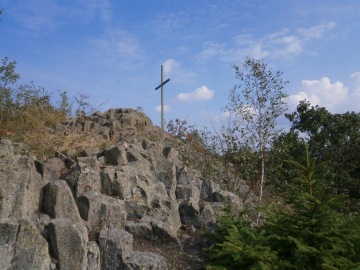
Jáchymov - Popov
5 Km
walk, bike
intensity3
High
PROHLÍDKA POSVÁTNÉHO OKRSKU
The original settlement from the 13th century Schlackenwerth (today's Ostrov) has undergone a very interesting historical development, as the oldest monument is the cemetery church. James from 1124. Thanks to its secure walls, the town became a refuge for merchants with rare goods and later became the property of the Šlik family, who pushed for a fundamental transformation of nearby Jáchymov. For the city, however, the most important event was the construction of the so-called. A sacred precinct with a castle park, which is often called the Eighth Wonder of the World.
Duke Julius Heinrich played a significant role in the creation of the whole complex, taking over the Island as his family seat. His wife Anna Magdalena founded a college of pious Piarist fathers here in 1666 and at the same time commissioned the Prague builder Martin Reiner to build a convent and the Church of the Annunciation of the Virgin Mary in close proximity to the funeral chapel of St. Anne.
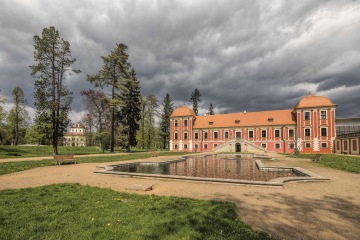
Popov - Ostrov
3,5 Km
walk
intensity 3
high
THROUGH THE LANDSCAPE OF BOREC PONDS
Less than 1.5 km north of the central part of Ostrov along the yellow tourist trail there is a picturesque system of ponds from the 17th century. Originally used to irrigate fields, it is now a suburban forest park. The largest of the ponds (Borecký) is still used for fish breeding. In the near future, the city plans to build a cycle path, hippo trail, nature trails and softball field. The whole area has become an important Natura 2000 site.
During a pleasant walk (or ride) you can enjoy the extensive stands of auricle and reed, among which the yellow flowers of irises shine. In the Karlovy Vary region, the area is also one of the last refuges of the great newt. And there are also popular waterfowl - ducks and swans can be admired here all year round
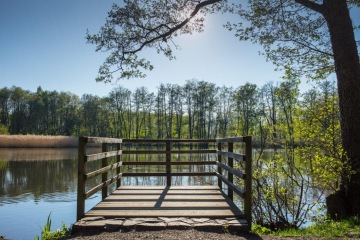
Ostrov - Borec pound
1,5 Km
walk, bus, bike
intensity1
low
Mountain biking through the Popov circuit
31,5 Km
Route marking
green, yellow
Shortened circuit with omitted nature trail - 24 km. The circuit is intended for more demanding cyclists, but in difficult passages you can dismount and walk. The path passes the Popovsky Cross. Continue along the nature trail Jáchymov hell, after which it will follow the Klínovec circuit "U klád" and the Central circuit behind Špičák (marked in yellow).
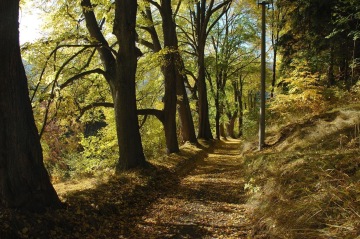
Imperial Alley
Church of St. Joachim - Mathesiova Street - Císařská alej - Marie Curie Sklodowska Primary School - LK Curie
The best way to start your walk through the Imperial Alley is at the Church of St. Joachim. It is located in the historical heart of Jáchymov, and to shorten the climb you will take a spa shuttle bus. The statue of St. John of Nepomuk from 1730 or the statue of the Holy Trinity on the Corinthian column from 1703 are definitely worth seeing. Stop by the beautifully restored house of mining master Hans Müller from Perneck from 1560 with preserved house sign - mill wheel, cuffs and threshing machine.
Ascending Mathesiova Street you will pass the house where the spiritual father of the town, the evangelical pastor and rector of the renowned Latin school, Jan Mathesius, spent a large part of his life. There is a memorial plaque on the house and today this house is the seat of the Barbora Mining Association. At the next crossroads turn right, and after a short climb you stand at the beginning of the alley.
The Imperial Alley consists of a magical path lined with lime giants, who were planted in 1898 - 1903 on the occasion of the 50th anniversary of the reign of Emperor Franz Joseph I. Their age is therefore estimated at 100 years. The circumference of the trunks in the most massive trees is more than 200 cm. The alley forms an impressive landscape dominant and at the same time a scenic route with beautiful views of the whole town of Jáchymov. At the end of the alley, you will descend to the Marie Curie Sklodowska Primary School building from the mid-50s. From here you can continue down the stairs to the CURIE Health Spa Hotel, where you can enjoy the experience of a nice walk in the café with a coffee or an ice cream sundae.
2 Km
walk
intensity 2
medium
New Town to Marianska
Barbora adit - towers of Freudenstein Castle - New Town - Mariánská - Eduard
OFrom the Barbora adit you will climb the winding road to the towers of Freudenstein Castle. It was built for the founder of the town of Jáchymov - Štěpán Šlik - in 1517 by Jan Munich. Already since 1519, the first Šlik thalers were minted in the cellars of the castle. During the Thirty Years' War the castle burnt down and since then it has been falling into disrepair. At present, only two towers remain. The smaller one served the mining office as a powder room. Higher - Šlikovka - was modified in the 19th century as a tower of the town watchman, who gave the miners a bell signal to start and end the shift.From Šlikovka it is not far to the New Town (919 m above sea level), from where you can enjoy unique views of Jáchymov and Klínovec, and the former settlement of Mariasorg - now Mariánské.
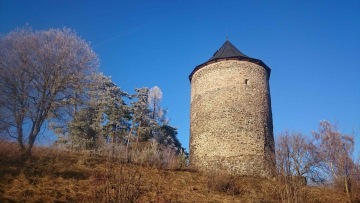
At the end of the 15th century, a hermit Jan Niavis lived in this place, who is said to have prophesied the glory of the mining town that would be founded here, its decline and a new resurrection. After the Thirty Years' War, when mining in the Jáchymov region was undergoing the greatest decline, several miners sought out the remains of Niavis's hermitage and built a chapel in its place, and later a pilgrimage church of the Virgin Mary. In 1754 this church was granted to the Capuchin Order, who built a second church here - monastery and Capuchin hospice.
After the abolition of the monastery (1948), the whole building was removed in 1964 - 65 due to its poor condition. A labour camp was established in its place - the most feared in the history of the "Jáchymov hell". Today, Mariánská is a popular center of tourism and skiing. From the trip you can also make a short detour to the former Eduard mine. You can find it near the Abertamy Junction. Now there is a considerable sports complex - biathlon center with a ski slope, lift, groomed cross-country trails and rimfire and air rifle shooting range.
5 Km
walk, bike
intensity 1
low
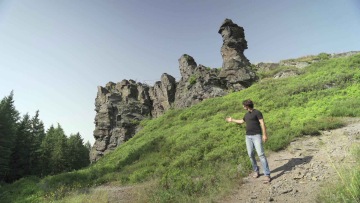
Jáchymov Hell
square Jáchymov - Jáchymov - Svornost - Mining open-air museum - City Pond - Hot Pond - Freudenstein
The historical educational trail Jáchymovské peklo was created thanks to the cooperation of the Barbora Mining Association, the Confederation of Political Prisoners, the Environmental Department and the Club of Czech Tourists from Karlovy Vary. Its main task is to recall the horrors of the labour camps in the Jáchymov region, through which more than 60,000 prisoners passed between 1948 and 1961.
The history of the Jáchymov hell began in 1945, when the Jáchymov mines were occupied by the Red Army. Initially, German prisoners of war and collaborators worked here. Over time, they were replaced by people convicted of their political disloyalty. In 1946, the national enterprise Jáchymovské doly was established, which was subject to a special regime of secrecy and protection and whose entire uranium production went to the Soviet Union.
The trail begins with a symbolic representation of individual communist camps - the so-called "Way of the Cross to Freedom", which under the Church of St. Jáchym was built by academic sculptor Roman Podrázský. Above the church, take the path on the left to the Svornost mine complex.
It is one of the oldest still active mines in Central Europe, and regularly drains healing radon water from a depth of 532 meters to your baths. Next to Svornost there is the Barbora adit. Further along the road, after a few meters you will find yourself at the Mining Open-Air Museum, built around about 260 m long adit. For the time being, it is not open to the public, but its opening is planned in the future, together with the connection with the old medieval adit "silver". The entrance is framed by a thick grid of water pipes to prevent prisoners from escaping. Nearby is a train that took care of the removal of mined rock from the mine, and above it all towers tower huge watchtowers. Around them, you can experience the daily journey of prisoners to the accommodation camp on 260 steps, surrounded by barbed wire. The only remnants remembling the existence of the camp today are only the so-called corrections (solitary confinement).Around the Jáchymov water supply and the mouth of the Vysoká fir adit you will reach the Municipal Pond - a water reservoir that used to power machines in mines. The nature trail will lead you through the territories of former mines, correctional labor camps and forced labor camps.
The trail also leads to the vicinity of the interesting ecosystem of the Hot Pond. In the surroundings of the ponds, built on the Eliášův stream, a number of protected animals and plants thrive (e.g. mountain newt or arnica prha). The journey ends at the remains of Šlik's Freudenstein Castle, in whose cellars silver thalers were minted from 1519.
Interestingness
In 1953, 15,000 prisoners mined about 554 tons of uranium in the Jáchymov region. By comparison, only 650 tonnes were mined in the previous 92 years.
25 Km
walk
intensity 3
high
Za skřítky poohří
Ostrov - Kyselka - Radošov - Šemnic rock - Angel Mountain
By car or perpendicularly, the best way to get to Kyselka is by road from the town of Ostrov, which you can connect to at the local train station.
The once magnificent spa town of Kyselka is unfortunately only reminiscent of the fragments of the spa area. Since the Middle Ages, mineral water springs with a rich carbon dioxide content have been known. The water originated on the slopes of Bukov mountain and was therefore called Beech acidulous water. In 1867, the Karlovy Vary entrepreneur Jindřich Mattoni began to use the springs and built a magnificent spa complex with a colonnade. In the local part of Kyselka - Radošov there is originally a Gothic church of St. Wenceslas. During the repair of its tower clock, it was found that it probably comes from the 14th century and is therefore the oldest functional machine of its kind in our country. But there is also another unique thing worth visiting - a wooden bridge from the 14th century.
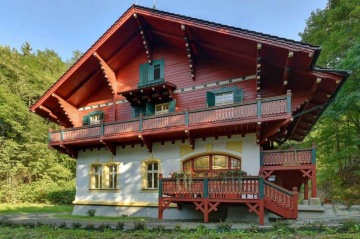
The bridge over the Ohře River stands on the historical "Royal Way", which has been used by merchants, military expeditions and visits of rulers since 1364. The bridge had a turbulent history, it even burned down several times. However, it was thoroughly repaired in 2001.
If you set out from Kyselka along the red tourist trail, you will pass the Bučina lookout with a beautiful view of the Ohře River and the Doupov Mountains and further along the yellow trail to the mysterious Skalka skřítků. In the rock wall you can see about sixty cylindrical cavities with a diameter of a few centimeters to 1.5 meters and a depth of up to 5 meters. The remarkable geological site is a protected natural monument, and was probably formed by weathering tree trunks in volcanic sediments. However, the local legend says that the holes were left in the rock by small permoníčci when they hid their treasure in it. Whoever wants to find it must go to the rock on Good Friday, when the rock opens.
From the turn-off to Rocks of gnomes you can continue along the red tourist trail to Šemnic rock. The steep jingle hill with a beautiful view is protected as a natural monument. From Kyselka you can get to Angel mountain after eight kilometers along a not very busy road (also a cycle path).
The town of Angel mountain with the romantic ruins of the castle of the same name from 1402 stands on a distinctive jingle rock. Directly at the foot of the castle rock rises the parish church of St. Michael. In addition to the castle ruins, there is a valuable religious monument on Andělská Hora, the former pilgrimage and cemetery church of the Holy Trinity from 1712. It was built according to the plans of G. B. Alliprandi and its peculiarity is a completely regular triangular layout. Near the church there is a memorable linden tree, where a spring once rose, whose water is said to have miraculously cured many sick pilgrims. Andělská Hora is a popular excursion destination for its dominant location with a long circular view.
55 Km
bike, car
intensity 2
medium

To the Upper Castle - Hauenštejn
Jáchymov - Dolní Žďár - Damice - Dubí - Upper Castle
From Jáchymov you go down to Ostrov, in Dolní Žďár turn towards Chomutov. After the village of Damice you will see a sharp turn to the Upper Castle on the left side. A narrow road will lead you to the parking lot, from where you have to walk to the castle gate. Passionate cyclists can recommend a more difficult path through the forest through the village of Beautiful forest. You can join it at the exit from Klínovec Smuggler Trail (see the Klínovec trip).
Nothing is known about the origins of Hauenstein Castle. Its name comes from the shapes Haue (i.e. hoe, axe or mallet) and Stein (rock), reflecting the fact that mining took place around the castle. Hauenštejn was sold in 1837 to Gabriele, Countess of Buquoy - Longueval. She had the whole building rebuilt in Neo-Gothic style. During World War II, the castle was used as a Hitlerjugend centre and after the war it served as a dormitory for the Jáchymov Mines.
The final end to the decay of the castle was its function as a children's detention home. At the end of the 20th century, the "West Bohemian Hluboká" (Hauenstein's nickname) was in a desolate state. It was not until 2000 that the castle came into private hands and in cooperation with various enthusiasts its gradual reconstruction is underway. Be sure to visit the castle during the summer. On weekends there are fun night tours, fencing performances and a fire show. The castle also regularly hosts the music festival 32 Folk Ohře.
12 Km
bike, car
intensity 2
medium
Contact Us
Do you have any questions? Write to us...
ADDRESS:
Visitor Information Centre of the Spa Jáchymov
T. G. Masaryka 388
362 51 Jáchymov
contact:
Tel.: +420 353 831 618
E-mail: infocentrum@laznejachymov.cz
PRIVACY STATEMENT
The operator guarantees all visitors to this server the protection of their personal data within the meaning of Act. No. 101/2000 Coll., On the Protection of Personal Data, and at the same time undertakes not to provide personal data in any form to a third party. Your data will be secured by law and used only in communication between the seller and the buyer.


